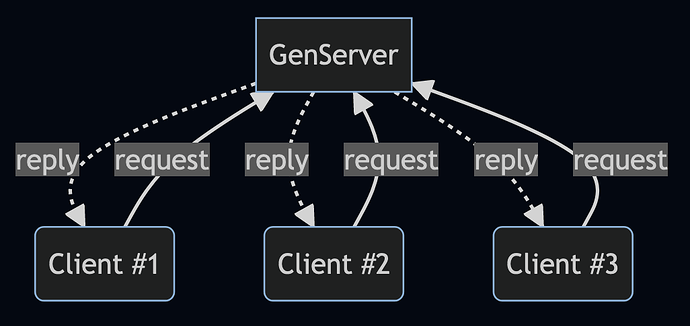Code snippets in diagnostics
Elixir v1.15 introduced a new compiler diagnostic format and the ability to print multiple error diagnostics per compilation (in addition to multiple warnings).
With Elixir v1.16, we also include code snippets in exceptions and diagnostics raised by the compiler. For example, a syntax error now includes a pointer to where the error happened:
** (SyntaxError) invalid syntax found on lib/my_app.ex:1:17:
error: syntax error before: '*'
│
1 │ [1, 2, 3, 4, 5, *]
│ ^
│
└─ lib/my_app.ex:1:17
For mismatched delimiters, it now shows both delimiters:
** (MismatchedDelimiterError) mismatched delimiter found on lib/my_app.ex:1:18:
error: unexpected token: )
│
1 │ [1, 2, 3, 4, 5, 6)
│ │ └ mismatched closing delimiter (expected "]")
│ └ unclosed delimiter
│
└─ lib/my_app.ex:1:18
Errors and warnings diagnostics also include code snippets. When possible, we will show precise spans, such as on undefined variables:
error: undefined variable "unknown_var"
│
5 │ a - unknown_var
│ ^^^^^^^^^^^
│
└─ lib/sample.ex:5:9: Sample.foo/1
Otherwise the whole line is underlined:
error: function names should start with lowercase characters or underscore, invalid name CamelCase
│
3 │ def CamelCase do
│ ^^^^^^^^^^^^^^^^
│
└─ lib/sample.ex:3
A huge thank you to Vinícius Muller for working on the new diagnostics.
Revamped documentation
Elixir’s Getting Started guided has been made part of the Elixir repository and incorporated into ExDoc. This was an opportunity to revisit and unify all official guides and references.
We have also incorporated and extended the work on Understanding Code Smells in Elixir Functional Language, by Lucas Vegi and Marco Tulio Valente, from ASERG/DCC/UFMG, into the official document in the form of anti-patterns. The anti-patterns are divided into four categories: code-related, design-related, process-related, and meta-programming. Our goal is to give all developers examples of potential anti-patterns, with context and examples on how to improve their codebases.
Another ExDoc feature we have incorporated in this release is the addition of cheatsheets, starting with a cheatsheet for the Enum module. If you would like to contribute future cheatsheets to Elixir itself, feel free to start a discussion with an issue.
Finally, we have started enriching our documentation with Mermaid.js diagrams. You can find examples in the GenServer and Supervisor docs.
v1.16.0-rc.0 (2023-10-31)
1. Enhancements
EEx
- [EEx] Include relative file information in diagnostics
Elixir
- [Code] Automatically include columns in parsing options
- [Code] Introduce
MismatchedDelimiterErrorfor handling mismatched delimiter exceptions - [Code.Fragment] Handle anonymous calls in fragments
- [Code.Formatter] Trim trailing whitespace on heredocs with
\r\n - [Kernel] Suggest module names based on suffix and casing errors when the module does not exist in
UndefinedFunctionError - [Kernel.ParallelCompiler] Introduce
Kernel.ParallelCompiler.pmap/2to compile multiple additional entries in parallel - [Kernel.SpecialForms] Warn if
True/False/Nilare used as aliases and there is no such alias - [Macro] Add
Macro.compile_apply/4 - [Module] Add support for
@nifsannotation from Erlang/OTP 25 - [Module] Add support for missing
@dialyzerconfiguration - [String] Update to Unicode 15.1.0
- [Task] Add
:limitoption toTask.yield_many/2
Mix
- [mix] Add
MIX_PROFILEto profile a list of comma separated tasks - [mix compile.elixir] Optimize scenario where there are thousands of files in
lib/and one of them is changed - [mix test] Allow testing multiple file:line at once, such as
mix test test/foo_test.exs:13 test/bar_test.exs:27
2. Bug fixes
Elixir
- [Code.Fragment] Fix crash in
Code.Fragment.surround_context/2when matching on-> - [IO] Raise when using
IO.binwrite/2on terminated device (mirroringIO.write/2) - [Kernel] Do not expand aliases recursively (the alias stored in Macro.Env is already expanded)
- [Kernel] Ensure
dbgmodule is a compile-time dependency - [Kernel] Warn when a private function or macro uses
unquote/1and the function/macro itself is unused - [Kernel] Do not define an alias for nested modules starting with
Elixir.in their definition - [Kernel.ParallelCompiler] Consider a module has been defined in
@after_compilecallbacks to avoid deadlocks - [Path] Ensure
Path.relative_to/2returns a relative path when the given argument does not share a common prefix withcwd
ExUnit
- [ExUnit] Raise on incorrectly dedented doctests
Mix
- [Mix] Ensure files with duplicate modules are recompiled whenever any of the files change
3. Soft deprecations (no warnings emitted)
Elixir
- [File] Deprecate
File.stream!(file, options, line_or_bytes)in favor of keeping the options as last argument, as inFile.stream!(file, line_or_bytes, options) - [Kernel.ParallelCompiler] Deprecate
Kernel.ParallelCompiler.async/1in favor ofKernel.ParallelCompiler.pmap/2 - [Path] Deprecate
Path.safe_relative_to/2in favor ofPath.safe_relative/2
4. Hard deprecations
Elixir
- [Date] Deprecate inferring a range with negative step, call
Date.range/3with a negative step instead - [Enum] Deprecate passing a range with negative step on
Enum.slice/2, givefirst..last//1instead - [Kernel]
~R/.../is deprecated in favor of~r/.../. This is because~R/.../still allowed escape codes, which did not fit the definition of uppercase sigils - [String] Deprecate passing a range with negative step on
String.slice/2, givefirst..last//1instead
ExUnit
- [ExUnit.Formatter] Deprecate
format_time/2, useformat_times/1instead
Mix
- [mix compile.leex] Require
:leexto be added as a compiler to run theleexcompiler - [mix compile.yecc] Require
:yeccto be added as a compiler to run theyecccompiler
























